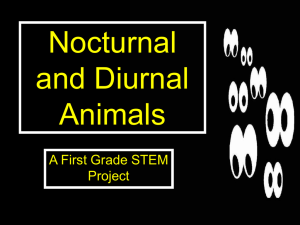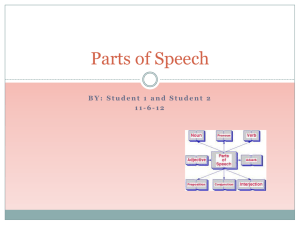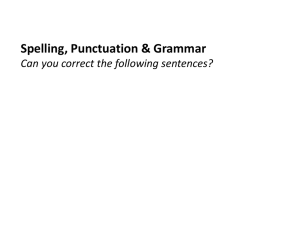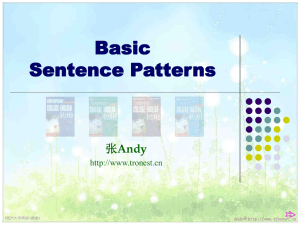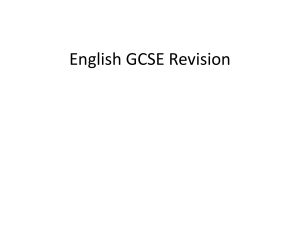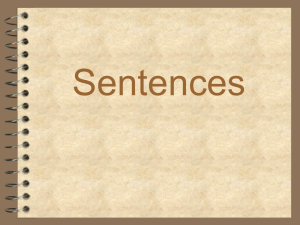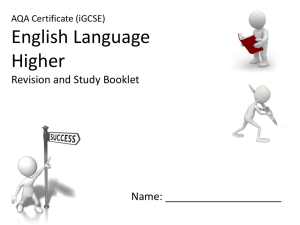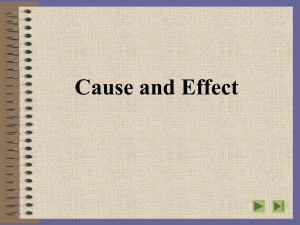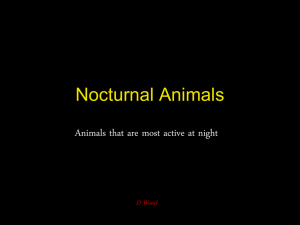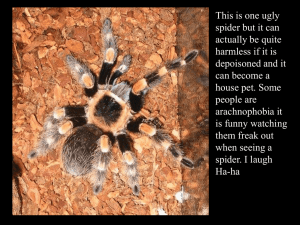Nat 5 Close Reading PPT
advertisement
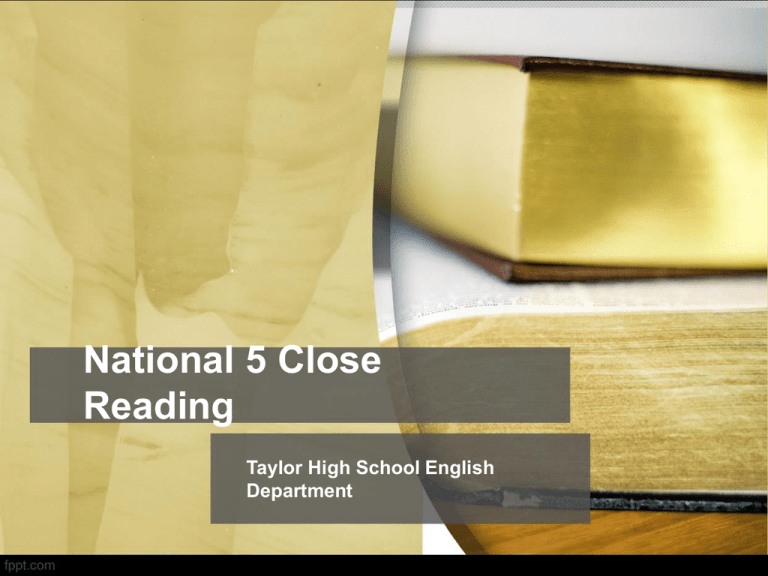
National 5 Close Reading Taylor High School English Department Close Reading • Close Reading aims to test your understanding of language. The questions will focus on: • What the writer is saying (Understanding) • How they writer says it (Analysis ) • How effectively he is saying it (Evaluation) Exam Technique • The art of answering test questions in the correct way is called “exam technique”. Often, marks are lost not through a lack of real understanding, but through failure to grasp exactly what is wanted by the examiners in certain types of question • The questions are always “directed”. This means you will be told to look at a particular section of the text to find the answers. You will be given pointers such as: • “In the first paragraph…” • “Look at lines …” • If you choose an answer from outside the section you will get NO marks ! Points of Exam Technique ! • Find the answer within the lines you are directed to • Note the number of marks available & give an answer of suitable length & amount of detail • Look carefully at what the question instructs you to do. Use your own words unless the answer asks you to quote UNDERSTANDING • The most common task is you will be asked to pick out a fact from the text and express it in your own words – we call this PARAPHRASING Example – Paraphrasing • Here is an example. The passage was about tarantulas and the narrator was the tarantula itself ! • “I’m nocturnal. I love the moonlight, the shadows, the dark places, the dappled murk. I’m not being poetic. I’m simply being true to my nature, my nocturnal nature. Like all tarantulas.” • Question: In your own words, in what way is the speaker like all tarantulas, according to the first paragraph ? (1 Mark) The steps to Answering ! • There are three steps to answering this type of question: • Step One: Look in the text for the information which will answer the question, in this case it is the word “nocturnal” • Step Two: Use your metalinguistic skills to work out what “nocturnal means” (Word Attack or Reading Around) • Step Three: Express the information in your own words (paraphrase it) Use a simple sentence which fits the way the question is worded. In this example you need to change the narrative voice from 1st person to 3rd person Now you try ! • Try to answer the question ! • Question: In your own words, in what way is the speaker like all tarantulas, according to the first paragraph ? (1 Mark) The answer ! • An acceptable answer would be: The speaker is active by night. Remember ! • If you were simply to say “The speaker is nocturnal” or “He or she is nocturnal” you would get no marks since you have failed to show that you know what the word “nocturnal” means and also that you have the vocabulary to put it into your own words ! • You may put the original word or words in brackets after your own version. This will make it quite clear to the examiner that you have focused on the right part of the text. • Remember: such additions, while helpful to the examiner, will cost you time & so should be kept to a minimum ! Summarisation ! • A variation on this kind of question is the task which asks you to pick out a number of points the writer makes and briefly summarise them in your own words. Such a question frequently includes the word “Summarise” Example ! • Here is an example again from the same paper. • Question: The speaker provides several pieces of evidence to support his argument that the fear of tarantulas is unjustified. Summarise the main ones given in lines 88-113 (3 marks) In this question the number of marks available (3) suggests the number of pieces of evidence to be found. Always remember to look carefully at the number of marks. You would be best to present your answer in a numbered format: 1.… 2.... 3.… • You could also go to the text and number the points on the text (1), (2) and (3) then all you need to do is paraphrase them. This will help you locate the information quickly as you are writing Warning ! • One of the most common errors in Close Reading is to write too much for a one mark question and not enough for a multiple mark question Meanings of Words • Another task set to test understanding is to explain the meaning of a word or phrase as used in the text. Again you will need to apply your metalinguistics to help you answer • The word “context” may be used here – context means the part of the text where the word is used Example ! • “Show how the context helps you understand the meaning of the word ‘nocturnal’.” (2 marks) • Look again at the opening paragraph ! • “I’m nocturnal. I love the moonlight, the shadows, the dark places, the dappled murk. I’m not being poetic. I’m simply being true to my nature, my nocturnal nature. Like all tarantulas.” 2 Steps to Answering ! • Step 1: Explain the meaning of the word • Step 2: Show how (quote) the rest of the text makes the meaning clear by quoting the word or words which provide clues Answer ! • An acceptable answer might be: Nocturnal means being active at night. The writer refers to his preference for “moonlight” and “dark” which both suggest night-time. Analysis • Analysis questions ask you to think about HOW the writer is expressing his ideas. A common fault of exam technique is to treat an analysis question as if it is understanding. Marks are often lost in these questions because candidates often explain what is being said rather than how it is being said. • Analysis questions will deal with aspects of style: sentence structure & punctuation; expression & word choice; figures of speech; the structure of argument & tone. • Look very carefully at the wording of the question to find out what is wanted. If the question asks you to “Quote” you may simply pick out a word or expression from the text. Such questions are usually only worth one mark. • Quote the expression that makes it clear… • However, more usually an answer to an Analysis question will require you to explain something in your own words. • Almost always you will be expected to quote something as well as providing an explanation in your own words. Here is a typical example of a question which requires you to both quote and comment: • Select one expression used to describe this and explain why you find it effective. Know your questions ! • Make a table in your jotter like the one on the next slide. Your teacher will give you a past paper, go through the questions and identify which questions are examples of each category Paraphrasing Summarising Context Sentence Structure • The most important thing is to know what is meant by sentence structure, and what answer it should refer to. You should not only describe the main features of sentence structure but also explain their effect. • Basically, the “structure” of the sentence means the way it is made up and how the various elements are arranged. The punctuation can be helpful in giving clues to the structure. • Step One: Look out for the types of sentence the writer uses •Statements •Questions •Commands •Exclamations •Minor Sentences •Stop •Questioning •Call •Eric’s Mother • Statements – tell you something. They end in a full stop. Most sentences are statements, so it is usually if other types of sentence are used that you will need to comment. Writing which is made up of statements alone may have a calm or impersonal tone. • Questions – ask something. They always end in a question mark. Using questions may challenge the reader, or show uncertainty in the writer. Look out for rhetorical questions, which do not expect an answer, eg, “What kind of an answer is that ?” Such questions aim to stir up strong feelings in the reader, such as anger. They create what is called an emotive tone, which simply means one which stirs up feelings or emotions • Commands – tell you to do something. “Think of a number.” They end with either a full stop or exclamation mark. They are often used in advertisements or where the writer tries to create the effect of speaking directly to the reader. • Exclamations – Express excitement or surprise. “How beautiful it was !” “What a place !” “Goodness gracious !” Exclamations do not always contain verbs. They often begin with “What” or “How”, like the first two examples, and end in an exclamation mark or full stop. Exclamations may also create an emotive or dramatic tone. • Minor Sentences – don’t contain a verb. Since they are abbreviations (shortened forms) of other types of sentences they may end in a full stop or question mark. “What now ?” “Time for a rest”. Such sentences will be very short & may create a tense or dramatic mood. They are typically informal language & may be used in direct speech, notes or diary entries. Such writing without verbs may also be called note form • You will never be asked to identify types of sentence, you will always be asked to explain the effect of choosing particular sentence types. This is only possible when you know the full context. Step Two: • Consider whether sentences are long and complex or short & simple • Long sentences containing several verbs & therefore several clauses are called complex. These are typical in English. Normally the more complex, the more formal the language. • We do not note a sentence is complex as it is not out of the ordinary Simple Sentences • Sentences with only one verb are called simple sentences. These are typical of speech & types of language used to communicate quickly & directly. Young children, for example, tend to use many simple sentences Step Three – Word Order • Look at the arrangement of words in a sentence, particularly longer ones. Some of the features may be worth commenting on Normal word order • Most sentences in the English language follow the order: • Subject • Verb • Object • Eg: The farmer shot the rabbit • In this sentence the subject of the sentence – the farmer • Does the action (verb) - shoots • To the rabbit (object) • This is an active sentence – the subject does the verb to the object • Again this is not unusual and not worth commenting on ! Inversion A reversal of normal word order is known as inversion • Inversion is the way Yoda speaks “Happy am I,” rather than “I am Happy !” Using inversion throws emphasis on to a particular part of the sentence – in this example the word “Happy” is stressed. • Often a pattern will be clear to see in a sentence • • • • Three patterns are specifically common: List Repetition Climax Parts of Speech • The words which make up a sentence are called parts of speech. There are eight parts of speech in English, which all have different functions: nouns, verbs, adjectives, adverbs, pronouns, prepositions, conjunctions and articles. It is useful to be able to identify these so you can comment if any part of speech is used in an unusual way to create a particular effect. Add each of these terms to your KAL section with a definition. • Conjunctions, which have a linking function, are often worthy of comment. In the case of verbs recognising the tense can be useful. In most narrative writing the past tense is used. If the present tense is used, or if the tense changes at some point, this may be well worth commenting on. • Be precise in describing the effects. You will get little credit for vague comments such as the writer uses a lot of adjectives or the writer uses long sentences broken up by commas !!!!!!!! Parenthesis • Parenthesis is when an extra piece of information is inserted into a sentence and enclosed by a pair of brackets (), commas, or dashes -. • Parenthesis may be a single words, phrase or a whole clause. While the grammar of the sentence would remain intact if the parenthesis were omitted, it will add something significant. It may make the meaning clearer, by adding an explanation or clarifying detail. • Parenthesis may also effect the tone by adding a comment which may be humorous or ironic.
